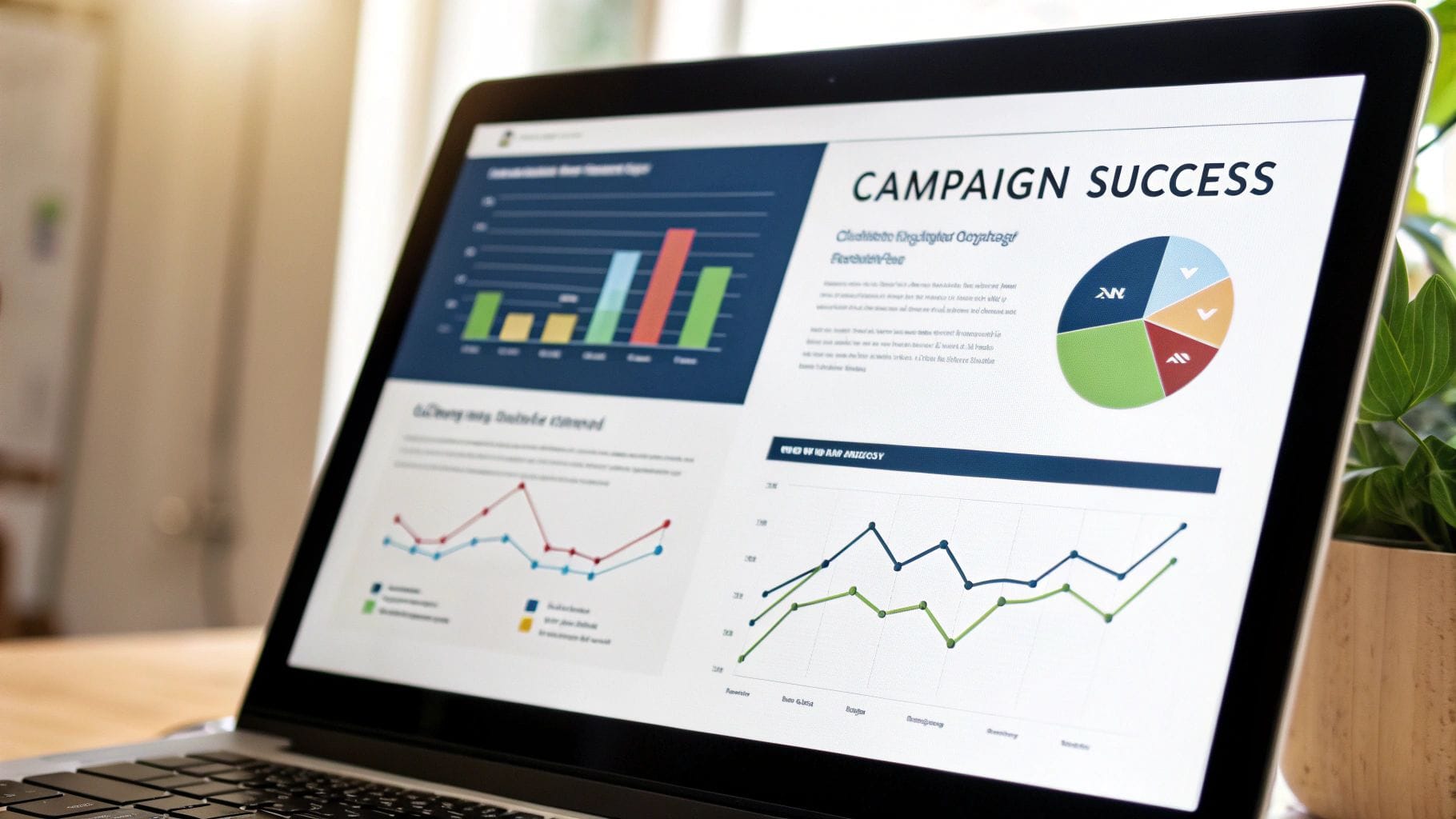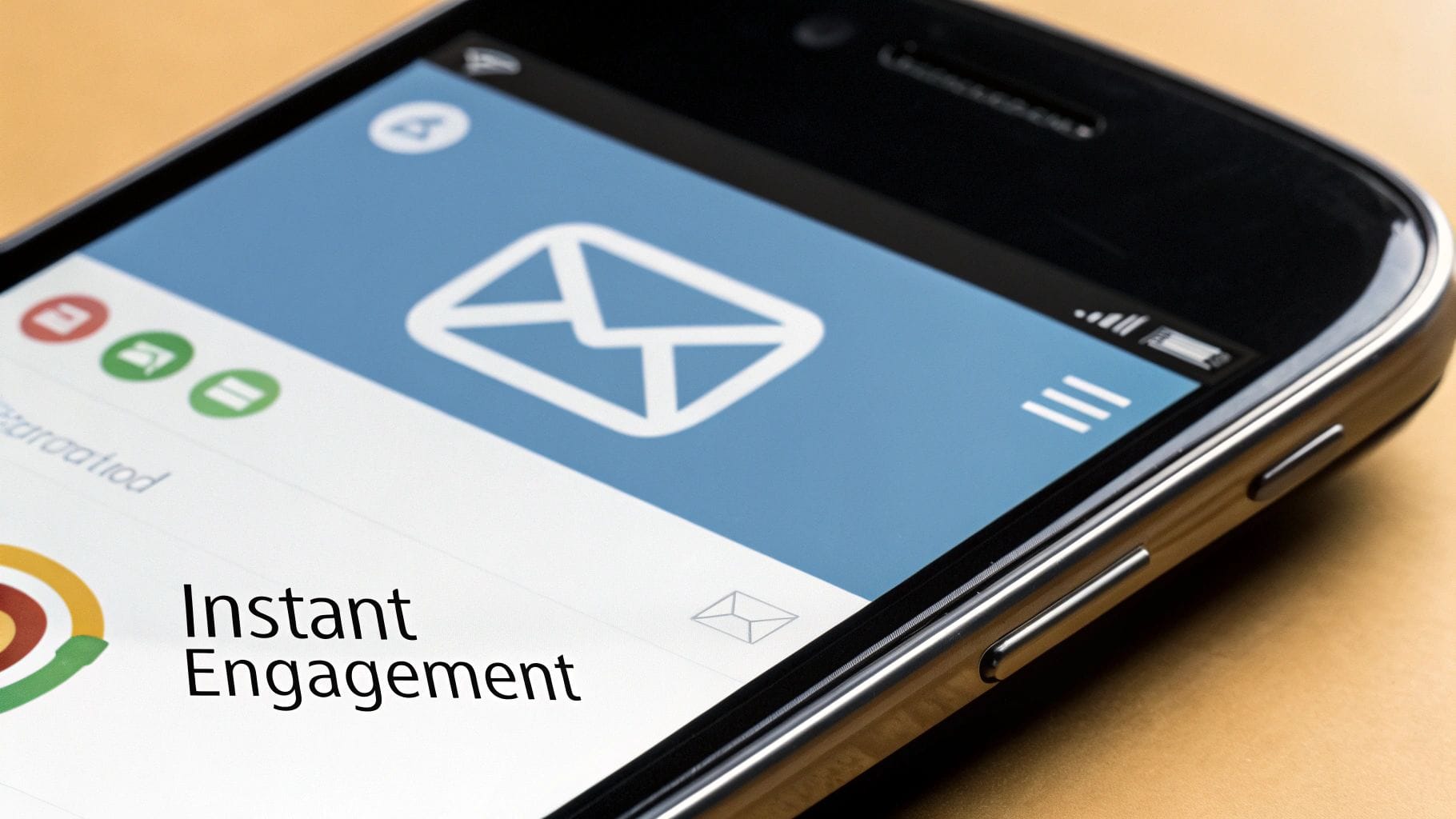10 Powerful Email Marketing Campaign Strategy Examples That Drive Results
10 Powerful Email Marketing Campaign Examples That Drive Results
Decoding High-Impact Email Campaigns
Every successful email marketing campaign needs a thoughtful strategy. Gone are the days of sending generic blast emails - today's most effective campaigns combine personalized content, compelling stories, and data-driven optimization to convert subscribers into loyal customers.
The Power of Personalization and Storytelling
Building real connections with subscribers requires going beyond basic personalization. Just like you'd rather receive a thoughtful handwritten letter than a generic flyer, email subscribers engage more with content that feels personally relevant. Smart brands now use customer data like purchase history, browsing behavior, and location to create truly customized experiences. They also weave authentic stories into their emails that align with their audience's values and aspirations. This combination of personalization and storytelling helps forge lasting relationships between brands and customers.
Examples of Successful Email Marketing Campaigns
Many companies are seeing great results from innovative email campaigns. One brand dramatically increased conversions by creating a welcome series that addressed each new subscriber's specific interests. Another effectively re-engaged inactive subscribers through targeted messages featuring exclusive offers and product recommendations based on past purchases. These examples show how combining personalized content with strategic messaging leads to better engagement and measurable business growth.
Optimizing for Mobile and Measuring Success
With most people checking email on their phones, mobile optimization is essential. Making sure your emails look great and function well on small screens, with easy-to-tap buttons and readable text, should be a top priority. You might want to check out How to master email design trends for 2024 for tips on mobile-first design. Beyond basic metrics like open and click rates, the most impactful campaigns track meaningful data like conversion rates, revenue, and customer lifetime value. Setting up proper tracking and consistently analyzing results helps identify what resonates with your audience.
From Strategy to Execution: Creating Impactful Campaigns
By applying these core principles and learning from successful examples, businesses can build email campaigns that truly engage subscribers and drive results. This means thoughtfully combining personalization, authentic storytelling, mobile-friendly design, and data analysis. From developing the initial strategy to executing each campaign, every element plays an important role in email marketing success. Focus on creating value for your subscribers while measuring what matters most for your business goals.
Crafting Mobile-First Campaign Experiences
Email opens on phones and tablets now far exceed desktop views. Creating campaigns that shine on mobile isn't optional - it's a basic requirement for success. When emails don't work well on mobile, it's like having a store with a locked front door - you might catch people's attention, but they won't be able to take action.
Designing for Thumbs and Tiny Screens

The key is starting with mobile layouts first, then adapting for larger screens later. This approach naturally leads to simpler designs and shorter copy that works better across all devices. Call-to-action buttons need special attention - they should be large enough for easy tapping and positioned where thumbs naturally rest near the top of the email. For example, placing a prominent "Shop Now" button within the first screen view can boost click rates significantly compared to buttons buried further down.
The Power of Interactive Elements
Elements like accordions, carousels and GIFs can make mobile emails more engaging while maximizing limited space. Rather than overwhelming subscribers with a long product list, a swipeable carousel lets them browse options smoothly. The key is testing these elements across major email platforms to ensure they display properly. A broken interactive feature is worse than none at all, so compatibility checking is essential.
A/B Testing for Mobile Optimization
Testing different versions of mobile emails reveals valuable insights about what works best. From subject line length to button placement to overall layout, small changes can have big impacts on results. For instance, shorter subject lines often perform better on mobile since they don't get cut off. Here's a sample of real A/B test findings:
| Element Tested | Version A | Version B | Results | |---|---|---|---| | Subject Line | Long & Descriptive | Short & Catchy | Short subject line saw a 15% increase in open rates | | Button Placement | Bottom of email | Above the fold | Above-the-fold placement led to a 25% increase in clicks |
The data from these tests helps fine-tune mobile campaigns over time. By carefully tracking what resonates with mobile readers and adjusting accordingly, brands can create emails that don't just reach mobile users but actually drive them to take action.
Mastering Personalization at Scale

Simply adding a subscriber's name isn't enough anymore when it comes to email personalization. The most effective email campaigns now use customer data to create meaningful, individualized experiences. By understanding how customers behave, what they prefer, and how they've interacted with your brand in the past, you can send the right message when it matters most. For example, compare a generic promotional email to one that suggests products based on what you've recently browsed – the personalized version feels much more relevant and is more likely to drive sales.
Segmentation: The Foundation of Personalized Email Marketing
Good personalization starts with smart audience segmentation. This means splitting your email list into smaller groups that share key traits like demographics, purchase history, website activity, or engagement levels. When you segment effectively, you can craft messages that truly matter to each group rather than sending one-size-fits-all content. It also helps prevent sending irrelevant emails that might make subscribers hit unsubscribe. For instance, it wouldn't make sense to promote laptops to someone who just bought one - instead, you could suggest accessories or software they might need.
Behavioral Triggers: Responding to Customer Actions
Taking personalization further, behavioral triggers automatically send emails based on specific customer actions. When someone abandons their shopping cart, a well-timed reminder email about those items can help recover the sale. Similarly, new subscribers can receive a welcome series that builds the relationship and encourages them to engage more. These automated yet personalized emails show customers you understand their needs and want to help them succeed. By delivering relevant content at key moments in their journey, each email can have maximum impact.
Dynamic Content and Predictive Personalization
Dynamic content lets you customize different elements within an email based on individual subscriber data. You might show different product recommendations, offers, or call-to-action buttons depending on which segment someone belongs to. This turns generic mass emails into individually crafted messages. Predictive personalization goes even further by using algorithms to anticipate what customers might want next based on their past behavior and trends. This proactive approach helps you suggest products they're likely interested in before they even search for them. For more details on creating personalized experiences, check out this guide on How to master email personalization.
Building effective personalized email campaigns requires both strategy and deep audience understanding. When you combine smart segmentation, behavioral triggers, and dynamic content, you can create emails that truly connect with subscribers and drive real results. Remember that true personalization goes far beyond adding someone's name - it's about crafting unique experiences that build lasting relationships with your customers.
Optimizing Campaign Timing and Frequency
The perfect email content is only effective when it reaches subscribers at the right time and frequency. Finding the optimal balance helps maximize engagement while keeping unsubscribes low. Let's explore how to move beyond generic best practices and make smart, data-driven decisions about your email schedule.
Finding the Sweet Spot: Why Timing and Frequency Matter
Email marketing is a delicate balance - too few messages and subscribers forget about you, too many and you risk overwhelming their inbox. Getting it right directly impacts your results - research shows that sending 9-16 emails monthly generates the highest ROI of 46:1. Like any relationship, it's about finding a natural rhythm that keeps your audience engaged without becoming intrusive.
Data-Driven Decisions: Testing Your Way to Success
There's no one-size-fits-all answer for email frequency. A daily deals site might thrive with daily emails, while a consulting firm may connect better monthly. The key is testing different schedules with your specific audience. Look beyond opens and clicks to monitor unsubscribes, conversions, and customer lifetime value. These deeper metrics reveal how frequency changes impact your overall marketing goals.
Examples of Frequency Optimization in Action
Real brands have seen great results by adjusting their sending patterns. One online store cut their emails from daily to three times weekly, leading to fewer unsubscribes and more sales. They realized daily messages overwhelmed customers. Another company created a preference center where subscribers could choose their preferred frequency. Giving subscribers control reduced opt-outs significantly, showing the value of adapting to individual preferences.
Building Responsive Sending Schedules
Smart marketers take frequency optimization further by creating schedules that adapt to each subscriber's engagement. This means sending more to highly engaged subscribers while scaling back for less active ones - like any good conversation, you match the other person's energy. For more insights on perfecting your timing, check out How to master your email newsletter timing for maximum engagement.
Through consistent testing and analysis, you can fine-tune your campaign timing and frequency to resonate with your specific audience and drive real business results. Remember - success comes from understanding not just how often to send, but when and to whom each message should go.
Converting Subscribers Through Strategic Sequences
Growing an email list is just the beginning. The key lies in nurturing those subscribers with carefully crafted email sequences that guide them toward becoming loyal customers. Success comes from sharing authentic stories that build trust, creating timely offers that motivate action, and designing calls-to-action that truly connect with your audience.
The Power of the Welcome Series
A well-designed welcome series sets the foundation for strong customer relationships. This automated sequence greets new subscribers and introduces them to your brand naturally over time. Rather than bombarding subscribers with one long welcome email, a series of 3-5 messages allows you to build familiarity step by step. You might start with a friendly welcome discount, share helpful guides based on their interests, or invite them to join your community. This gradual approach shows subscribers you're there to help, not just sell.
Abandoned Cart Emails: Recapturing Lost Sales
Cart abandonment emails are particularly effective at recovering potential sales. With nearly 70% of online shopping carts left behind, a gentle reminder sequence about forgotten items can bring shoppers back to complete their purchase. A limited-time discount often provides the extra motivation needed. For more ideas on bringing back customers who've drifted away, check out: Re-engagement Email Campaigns: Get Your Customers Back.
Product Launch Sequences: Building Excitement
Product launch sequences generate interest and anticipation through a series of well-timed messages. Early emails hint at what's coming while highlighting key benefits. Follow-up messages might offer exclusive pre-order deals or early access. The sequence culminates in an exciting launch day announcement that encourages immediate action. This step-by-step buildup creates natural momentum toward the release.
Nurturing Leads with Educational Content
Not every email sequence needs to focus on making an immediate sale. Educational content establishes your brand as a helpful resource by sharing valuable industry knowledge. A financial advisor might explain investment basics, while a fitness coach could offer workout tips and recipes. This approach earns trust by consistently delivering useful information before asking for any purchase.
Measuring Success: Beyond Open Rates
While open and click rates matter, the true measure of email marketing success is its impact on business goals. Looking at conversion rates, revenue, and customer lifetime value gives a fuller picture of what's working. Regular analysis of these key metrics helps identify your most effective sequences and refine them over time. This data-driven approach ensures your email marketing directly supports business growth.

Measuring What Actually Matters

The real value of email marketing goes far beyond basic tracking metrics. While crafting great content and mobile optimization matter, successful campaigns require focusing on measurements that directly impact your business goals. This means looking past surface-level numbers to understand what genuinely connects with your audience and grows your company.
Beyond Vanity: Focusing on Key Performance Indicators
Think about it like fishing - simply counting how many fish swim by your boat doesn't put any food on the table. You need to actually catch fish to succeed. The same applies to email marketing - high open rates might look impressive, but if they don't lead to sales or other concrete results, they're just numbers. Focus instead on metrics that show real business impact, like conversion rates, revenue generated, and the long-term value you get from each customer.
Connecting Email Performance to Business Growth
Let's say your main goal is increasing sales. You'll want to track exactly how many purchases come directly from your email campaigns. This means setting up proper tracking systems that connect email engagement to actual sales data. Look at metrics like the average order size from email versus other channels. By examining the full customer journey from email open to final purchase, you get a clear picture of how your campaigns drive real business results.
Advanced Testing Methodologies: Unveiling True Insights
While A/B testing helps optimize campaigns, don't just test small elements like button colors. Test different content types, messaging approaches, and sending schedules to find what creates meaningful engagement. Consider running multivariate tests to understand how multiple changes work together. This deeper testing often reveals surprising insights you'd miss with simpler A/B tests. For more details on tracking and analysis, check out: How to master email reporting and metrics.
Continuous Improvement: The Key to Long-Term Success
Great email marketing requires ongoing testing, measurement and refinement. Review your campaign data regularly to spot trends and patterns. Build on what works well, but don't be afraid to try new approaches. Since email marketing practices and user behaviors change frequently, stay flexible and let data guide your decisions. What succeeded last month may not work next month, so keep analyzing results and adjusting your strategy to maintain strong performance aligned with your business objectives.
Ready to take your email marketing to the next level? Inagiffy offers complete newsletter services including strategy, content creation, technical optimization and performance tracking. Visit us today to learn more.
Comments
Your comment has been submitted successfully!